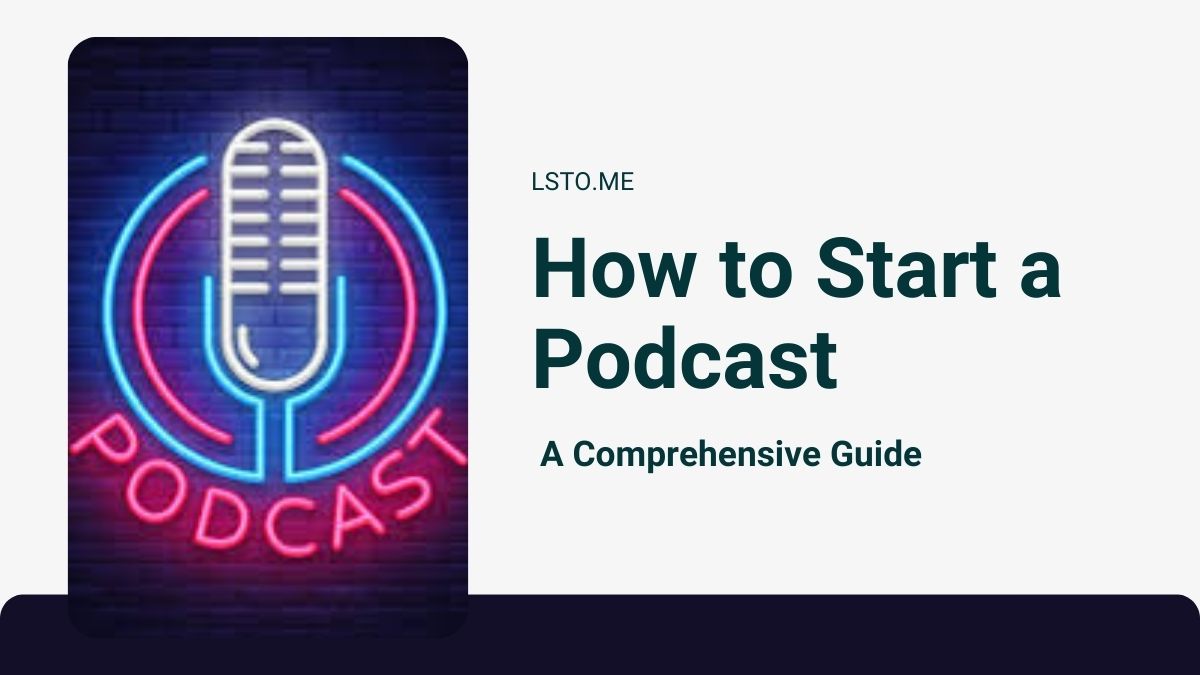
Podcasting has become one of the most popular and accessible forms of media today. Whether you’re an expert in a specific field, have a passion you want to share, or simply want to entertain and engage with an audience, starting a podcast can be a rewarding endeavor. This comprehensive guide will walk you through the steps to launch your very own podcast, from concept to publication.
Step 1: Define Your Concept
1.1 Choose Your Topic
The first step in starting a podcast is deciding what you want to talk about. Consider your interests, expertise, and the potential audience. It’s essential to choose a topic that you’re passionate about, as this will keep you motivated and engaged.
Tips:
- Brainstorm a list of potential topics.
- Research existing podcasts to see what’s already out there.
- Find a unique angle or niche within your chosen topic.
1.2 Identify Your Target Audience
Understanding who you’re creating your podcast for is crucial. Your target audience will influence your content, tone, and marketing strategies.
Questions to consider:
- What are the demographics of your ideal listener?
- What are their interests and pain points?
- How can your podcast provide value to them?
1.3 Choose a Format
Podcasts come in various formats, including interviews, solo commentary, panel discussions, and storytelling. Choose a format that suits your topic and style.
Common formats:
- Interview: Host interviews guests who are experts or have interesting stories.
- Solo: Host shares insights, tips, or stories alone.
- Co-hosted: Two or more hosts discuss topics together.
- Panel: A group of people discusses a topic.
- Storytelling: Narratives or documentary-style episodes.
Step 2: Plan Your Content
2.1 Create an Episode Outline
Planning your content ahead of time will help you stay organized and consistent. Create an outline for each episode, including main points, segments, and any guest contributions.
Tips:
- Start with a strong introduction.
- Break the episode into segments.
- End with a clear conclusion or call to action.
2.2 Develop a Publishing Schedule
Consistency is key in podcasting. Decide how often you’ll publish new episodes and stick to that schedule. Whether it’s weekly, bi-weekly, or monthly, make sure it’s manageable for you.
2.3 Prepare a Content Calendar
A content calendar will help you plan topics and guests in advance, ensuring you have a steady stream of content. Include recording, editing, and publishing dates.
Step 3: Gather Your Equipment
3.1 Essential Equipment
You don’t need a professional studio to start a podcast, but investing in some quality equipment can make a big difference in your audio quality.
Basic equipment:
- Microphone: A good quality USB or XLR microphone. Popular choices include the Blue Yeti or Audio-Technica ATR2100.
- Headphones: Over-ear headphones to monitor your audio.
- Pop Filter: Reduces plosive sounds and improves audio quality.
- Boom Arm or Stand: Keeps your microphone steady and at the right height.
3.2 Recording and Editing Software
There are various software options available for recording and editing your podcast.
Popular choices:
- Audacity: Free and open-source audio editing software.
- GarageBand: Free for Mac users, easy to use with good editing features.
- Adobe Audition: Professional-grade software with a wide range of features (paid).
3.3 Additional Accessories
Depending on your setup, you might also consider:
- Audio Interface: Converts your microphone’s analog signal to digital if using an XLR mic.
- Acoustic Treatment: Foam panels or blankets to reduce echo and background noise.
Step 4: Record Your Podcast
4.1 Set Up Your Recording Space
Choose a quiet location with minimal background noise. Set up your microphone, pop filter, and any other equipment. Test your setup to ensure everything is working correctly.
4.2 Record Your First Episode
Once your setup is ready, it’s time to record. Speak clearly and confidently. It might take a few tries to get comfortable, but that’s okay.
Tips:
- Do a test recording to check audio levels.
- Record in segments to make editing easier.
- Keep background noise to a minimum.
4.3 Edit Your Recording
Editing can make a significant difference in the quality of your podcast. Remove any mistakes, long pauses, or background noises. Add intro and outro music to give your podcast a professional touch.
Basic editing steps:
- Remove unwanted parts.
- Adjust audio levels.
- Add music or sound effects.
Step 5: Publish and Promote Your Podcast
5.1 Choose a Hosting Platform
A podcast hosting platform stores your audio files and distributes your podcast to directories like Apple Podcasts, Spotify, and Google Podcasts.
Popular hosting platforms:
- Buzzsprout
- Libsyn
- Anchor
- Podbean
5.2 Submit Your Podcast to Directories
Once you have your hosting platform set up, submit your podcast to various directories to reach a wider audience.
Major directories:
- Apple Podcasts
- Spotify
- Google Podcasts
- Stitcher
- Amazon Music
5.3 Promote Your Podcast
Promotion is key to growing your audience. Utilize social media, your website, and other channels to get the word out.
Promotion tips:
- Share episodes on social media.
- Create a website or blog for your podcast.
- Collaborate with other podcasters.
- Engage with your audience through comments and messages.
Step 6: Grow and Monetize Your Podcast
6.1 Engage with Your Audience
Building a loyal audience requires engagement. Respond to comments, ask for feedback, and create opportunities for listener interaction.
6.2 Monitor Your Analytics
Most hosting platforms provide analytics on your podcast’s performance. Use this data to understand your audience and improve your content.
6.3 Monetize Your Podcast
Once you’ve built a solid audience, you can explore monetization options.
Monetization methods:
- Sponsorships: Partner with brands to advertise on your podcast.
- Donations: Use platforms like Patreon for listener support.
- Merchandise: Sell branded merchandise to your audience.
Conclusion
Starting a podcast requires planning, dedication, and a bit of creativity, but it can be an incredibly rewarding experience. By following these steps, you’ll be well on your way to creating a podcast that resonates with your audience and stands out in the crowded podcasting space. Remember, the most important thing is to enjoy the process and be persistent. Happy podcasting!




